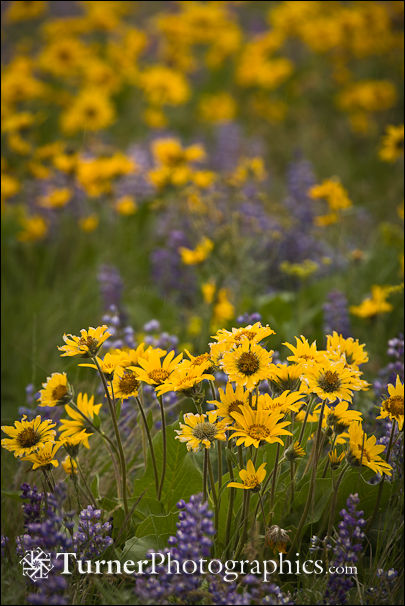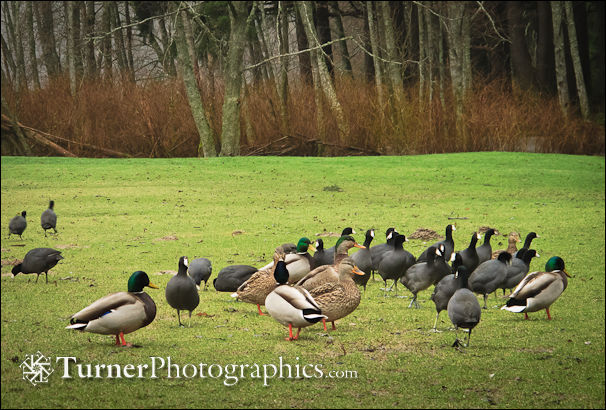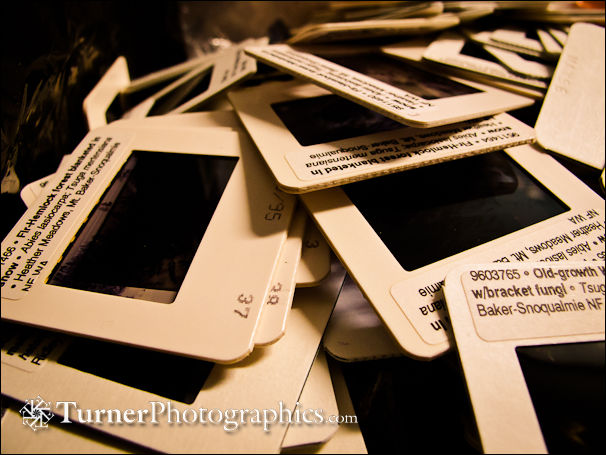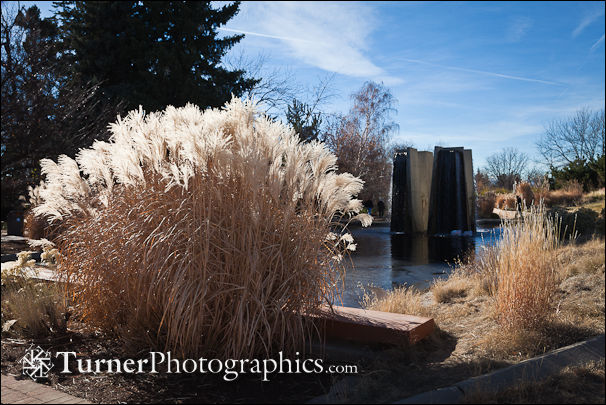Change Your Lens, Change Your Photo
You know that a wide-angle lens includes a lot more in the picture than a telephoto lens. You also know that the wide-angle expands the sense of space, making objects close to the camera much larger in relation to those farther away.

Here’s a dramatic example of the difference. This photo, shot with a 16mm lens on my full-frame sensor Canon 5d Mark II camera, was made yesterday morning on Hayward Hill near Thorpe, Washington. The hillside was covered with balsamroot and lupines, a typical combination for this part of central Washington in the spring.
Notice how the flowers expand into your experience. I placed the camera fairly high and shot down on them to keep a white drizzly sky out of the frame, but included as much of the hillside as possible. The flowers were 0.410 meters (about 1 foot, 4 inches) from the lens. You can see there’s quite a bit of space between the balsamroot in the foreground and the lupines behind them, as well as the next clumps of balsamroot on up the hill.

In the second photo we’re looking at the same group of flowers, but this time photographed with a 400mm lens. That’s my 70-200 with a 2x extender at the maximum zoom. Here I’ve backed off from the flowers, which took me down the hill. Now the lens is 8.4 meters (about 27 feet, 6 inches) from the flowers. The balsamroot flowers are actually smaller in the frame than in the first photo. Just because you shoot with a longer lens doesn’t necessarily make the subject bigger.
Now the foreground flowers are clearly isolated from the background by shallow depth of field, but at the same time those background flowers are much larger and apparently closer to the ones up front. This is the telephoto compression effect.
Both of these photos were made at f/8 so you can also see the dramatic difference in depth of field between the wide and telephoto variations.
These are just the two extremes of a series of images I made of these flowers. See them all on the Kittitas May 25 page of Pacific Northwest Wildflowers. I shot the series to go into the slide lecture I use when teaching flower photography.
Next time you’re out photographing, try experimenting with different lenses as you work the same subject. It’s a great learning experience regardless of whether you use a big digital SLR or a tiny pocket camera. You may surprise yourself, discovering you like a different variation than you expected.
For those particularly interested, the arrow-leaved balsamroot is Balsamorhiza sagittata and the lupines are Lupinus sulphureus.





 When you’re tiny and looking to get pollinated this early in the season you’ve gotta put on a show. At least that’s one way to look at this Common Filbert, Corylus avellana, blossom. All that feathery red stuff is part of the female flower. Dangling in the background are the long male catkins which soon will be releasing drifts of pollen to be carried across the void.
When you’re tiny and looking to get pollinated this early in the season you’ve gotta put on a show. At least that’s one way to look at this Common Filbert, Corylus avellana, blossom. All that feathery red stuff is part of the female flower. Dangling in the background are the long male catkins which soon will be releasing drifts of pollen to be carried across the void. Here are the male flowers on the same plant. Each dangling catkin has many individual blossoms. Last year’s foliage is still on some of the branches, weathered to a nice shade of brown.
Here are the male flowers on the same plant. Each dangling catkin has many individual blossoms. Last year’s foliage is still on some of the branches, weathered to a nice shade of brown.


 Resist the temptation. Do not get in a hurry to cut down those spent flower stems when the blooms fade.
Resist the temptation. Do not get in a hurry to cut down those spent flower stems when the blooms fade. I’m excited to be teaching wildflower or garden photography classes in several places in 2011. Some classes concentrate on using your digital SLR and others on getting the most from your pocket camera. If you’ve been in one of my classes before you know that I spend lots of time with each student, answering questions, suggesting ways to improve, and providing positive and thoughtful critiques. Tell your friends, and encourage them to sign up for one of my classes this coming year.
I’m excited to be teaching wildflower or garden photography classes in several places in 2011. Some classes concentrate on using your digital SLR and others on getting the most from your pocket camera. If you’ve been in one of my classes before you know that I spend lots of time with each student, answering questions, suggesting ways to improve, and providing positive and thoughtful critiques. Tell your friends, and encourage them to sign up for one of my classes this coming year. 